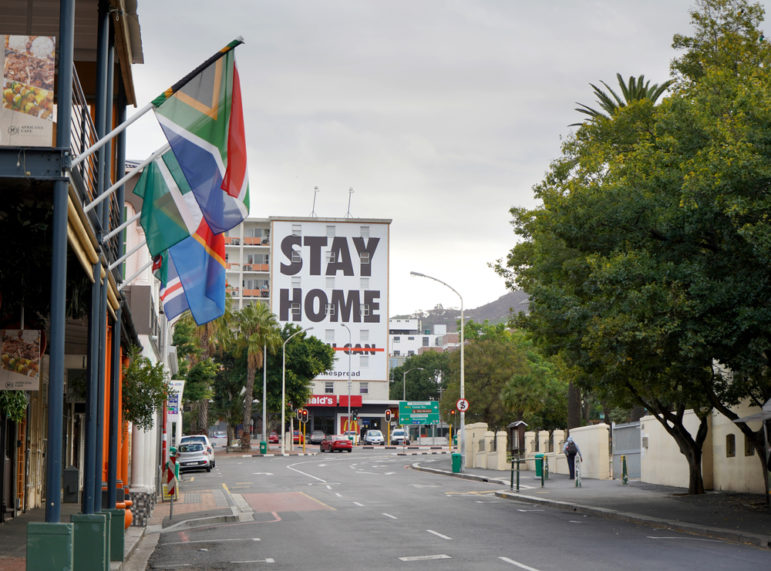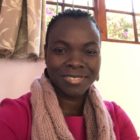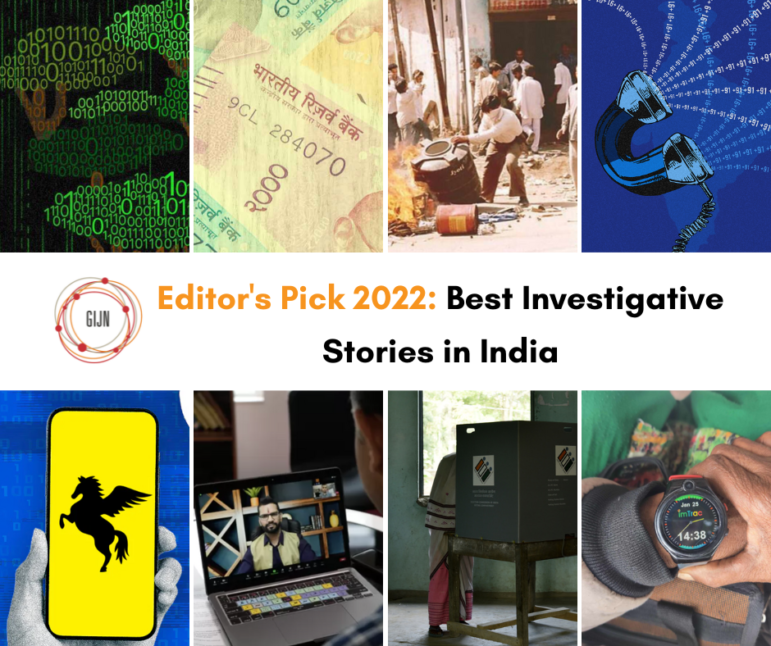

Image: Shutterstock
Saving Journalism, Part Two: In Africa, A Dearth of Support Amid the Pandemic
This is the second in a three-part series of excerpts from Saving Journalism 2: Global Strategies and a Look at Investigative Journalism, a new research project led by Anya Schiffrin at Columbia University and published by the Konrad Adenauer Stiftung. This portion of the report was written by Theodora Dame Adjin-Tettey. It is republished here with permission.
African journalism, too, felt the effects of the COVID-19 pandemic and also faced layoffs, newsroom closings, and cutbacks. The Nation Media Group in Nigeria laid off a fifth of its workforce and the South African Broadcasting Corporation (SABC) laid off more than 600 workers in 2020.
For most outlets, there were no public subsidies and little state financial support. The government support available was not media-specific: In countries like Ghana, the government provided financial help for small to medium enterprises, while in South Africa the Department of Labour introduced the Unemployed Insurance Fund (UIF) to support workers and businesses. News organizations in Africa were encouraged to consider other models like subscriptions, memberships, and donations to generate revenue. Several capacity-building training programs were provided by media development organizations and international donors in 2020 to help journalists cover the pandemic effectively. In Liberia, the US Embassy offered online training on coronavirus reporting. In The Gambia, the Press Union’s training arm organized online training for journalists and produced an information sheet on safety tips for reporters.
Some local and international donors and media development organizations provided support for certain kinds of programs meant to provide quality information about the pandemic. In Liberia, the Center for Media Studies and Peace Building runs a weekly radio program on Prime FM — the “COVID-19 Media Content Monitoring and Awareness Project” — with funding support from the Open Society Initiative of West Africa. Efforts were made to increase donor funding to support journalism in some African countries in 2020 and 2021.
Among the funding opportunities available in 2020 and 2021 aimed at Africa-based media organizations and journalists was the Africa-China Reporting Project in the journalism program at South Africa’s University of the Witwatersrand, which invited journalists to submit proposals for reporting grants of up to $1,500 to investigate COVID-19 “ground-level responses, capacity, successes/failures, shortcomings, services, and collaborations in African countries, communities, and organizations.”
Still, most of the support media organizations received from government, the private sector, and NGOs in many African countries in 2020 came in the form of personal protective equipment (PPE), such as face masks, sanitizers, and health kits like water buckets and soap. In Nigeria, no protective kits were provided to journalists by the government.
In South Africa, the Department of Labour, through the UIF, introduced the COVID-19 temporary relief scheme to support workers and businesses (including media workers and organizations) affected by the pandemic. With sufficient proof, individuals who lost their jobs or whose working hours were reduced by their employers could receive a maximum benefit of up to R6,730 (about US$442) per month for three months. Those whose companies had put them on unpaid leave, who had been laid off temporarily, or whose companies could only afford to pay a part of their salaries could also get a special payout from the UIF.
In Ghana, there was no formal government or private-sector support to the media during the pandemic, even though the government provided financial support for small to medium enterprises in general. Nor were Nigerian media outlets supported financially by the government. With private media suffering the brunt of the pandemic, some media players in Nigeria called on the government to support them financially — however, no financial relief packages were forthcoming. And even though some local governments promised palliative measures to support the media, not much had surfaced at the time of writing.
Similarly, in The Gambia, there was no formal government support during the year. Besides, although the government is the biggest advertiser in the country, it did not pay for advertising placed in the media because it maintained government funds were being used to fight COVID-19. In Sierra Leone, the Sierra Leone Association of Journalists (SLAJ) had to call for support in the form of airtime for media organizations due to the additional burden placed on media organizations and journalists to resort to digital technologies to carry out their mandate. The National COVID-19 Emergency Response Centre of Sierra Leone responded and gave the media airtime for COVID-related programs only.
News organizations in Africa were encouraged to consider other models to generate revenue, such as subscriptions, memberships, and donations. South Africa has some robust subscription and membership models, and during the period, many of these outlets consolidated their enterprises, while others had to explore such options in hybrid formats. However, not much is known about how media organizations elsewhere in the region took on those initiatives and whether they yielded any results. Nevertheless, many media organizations are going digital and moving online to attract revenue.
Capacity-Building Support
Several capacity-building training programs were provided by media development organizations and international donors in 2020 to help journalists cover the pandemic effectively. As mentioned earlier, in Liberia the US Embassy offered online training on coronavirus reporting. In Nigeria, reporters received training from NGOs in health reporting.
In Sierra Leone, SLAJ provided risk-communication training for some journalists, while the United Nations Development Programme offered training on countering fake news around COVID-19 and guidelines for reporting during emergencies. The Independent Media Commission of Sierra Leone also provided training on ethical reporting.
Support for COVID-19-Related Programming
Some local and international donors and media development organizations provided support for certain kinds of programs that were meant to provide quality information about the pandemic. The weekly radio program in Liberia run by the Center for Media Studies and Peace Building, mentioned above, seeks to identify fake news related to COVID-19 and have experts and relevant officials address specific issues. In Sierra Leone, the BBC supported programming on COVID-19, while the European Union and SLAJ supported efforts aimed at addressing fake news and misinformation around COVID-19.
The Taxonomy of Interventions — More Funding
Although small compared to other parts of the world, some efforts were made to increase donor funding to support journalism in some African countries in 2020 and 2021. Most of these involved foreign aid, while a few provided venture capital or local developmental support and were meant for independent reporting during the pandemic. In most cases, African journalists had to compete with reporters in other regions when applying for these funds. Google’s global Journalism Emergency Relief Fund, aimed at supporting small and midsized organizations providing local news, was accessible to African media. So was UNESCO’s $500,000 Global Media Defence Fund, which supported projects to improve legal protection for reporters and to fund investigative journalism focused on fighting legal impunity for crimes against journalists. The National Geographic Society also announced emergency grants ranging from $1,000 to $8,000 for journalists around the world who wished to cover evidence-based stories on the preparation, response, and impact of COVID-19 in underserved communities, so as to expose the inequalities resulting from the pandemic.
There was also a global journalism relief fund of $2,000 per request administered by the International Women’s Media Foundation, which was open to women-identifying journalists who faced significant financial hardship, lost their work, or were laid off during the pandemic. The Check Global program was launched by Meedan, a nonprofit technology company based in the US, Brazil, and Canada to provide microgrants of up to $500 for individuals, $2,000 for organizations, and $2,500 for collaborative projects to support independent media, fact-checkers, citizen journalists, activists, and technology and digital literacy initiatives in emerging economies, including Africa and Latin America.
In October 2021, the World Association of Newspapers and News Publishers (WAN-IFRA), with support from the Ministry of Foreign Affairs of Denmark, called for applications for its Climate Change and Environmental Reporting grants of $10,000 to support reporting on underreported community-based innovative solutions that promoted positive environmental change in Botswana, Kenya, Malawi, Rwanda, South Africa, Tanzania, Uganda, Zambia, and Zimbabwe.
WAN-IFRA also initiated a three-year project in 2021 to improve the security and safety of journalists and newsrooms, and to “increase media-led advocacy around press freedom and gender-related issues.” The project is meant to support up to 25 organizations with resources to assess their approach to safety, knowledge, preparedness, and responses to threats; and to participate in training and receive assistance to strengthen and build media-led advocacy relevant to local journalists. Beneficiary organizations are to also receive editorial, business development, and mentoring opportunities and be assisted with micro-grants to finance public interest reporting.
In southern Africa, the South Africa Media Innovation Program rolled out in 2021 to assist media innovators from five countries — Botswana, Lesotho, Namibia, Zambia, and Zimbabwe — in five new independent media initiatives. The program provided grants from US$5,000 to $15,000, as well as technical assistance and capacity building for each participating organization.
The initiatives supported were meant to enhance the sustainability of organizations, including developing new audiences and products, and exploring new revenue prospects.
Also, the Media Development and Diversity Agency, a statutory development agency that promotes and assists community media and small commercial media in South Africa, in 2020 administered about R60 million (about US$3.9 million) in emergency-response funding and grant funding to qualifying community-based nonprofit media and small commercial media affected by the pandemic.
New Business Models
Some media organizations that want to hedge themselves against economic risks are diversifying their enterprises, while some are trying subscriptions and sponsorship models to generate multiple revenue streams. For example, Big Cabal Media in Nigeria has a tech-news site called TechCabal, a subscription-only website that covers tech called Stears Business, as well as a research, advisory, and consulting business known as Stears Data. In 2020, the company raised $600,000 in seed investment from local investors and Luminate, a global philanthropic organization, and received some funding from the Co-Creation Hub (CcHUB), a technology-oriented center based in Nigeria, for its funding cycle in 2021. Many traditional media in Africa are also trying to generate revenue through their websites and social media.
At the South African National Editors’ Forum’s (SANEF) Media Ethics and Credibility Conference in May 2021, there was a proposal for the establishment of a media sustainability fund to “support the development, sustainability, and independence of public interest journalism and strengthen ethical practices in the media.” Through negotiations with government, corporate South Africa, funders, and civil society, SANEF hopes to lobby for tax relief, subsidies, and other state support to support a thriving, diverse, and innovative media ecosystem. With the necessary resources in place, they hope to support media and information literacy training and programs; public-interest reporting projects; and local content production. SANEF will also create a platform to explore other income-generating models for news media.
Public Subsidies, and a Tax on Tech Platforms
The Media Foundation for West Africa’s 2020 report on media development and sustainability in the region proposed funding models that go beyond direct payments to cover tax relief and subsidies as well as tax incentives for media equipment acquisition. Apart from SANEF’s intended negotiations with the South African government for tax relief and public subsidies, little has been heard of similar efforts by media players in other African countries.
African media players and relevant institutions have yet to initiate discussions and possible implementation of taxation on technology platforms to support media development.
Additional Resources
Considering a Membership Model for Your Newsroom? There’s a Guide for That
From Traditional Journalism to Sustainable Journalism
How Necessity Drives Media Innovation in North Africa
 Theodora Dame Adjin-Tettey is a postdoctoral fellow on the National Research Foundation-funded Licence to Talk research project at the School of Journalism and Media Studies, Rhodes University, South Africa. She is also a lecturer at the University of Ghana.
Theodora Dame Adjin-Tettey is a postdoctoral fellow on the National Research Foundation-funded Licence to Talk research project at the School of Journalism and Media Studies, Rhodes University, South Africa. She is also a lecturer at the University of Ghana.












